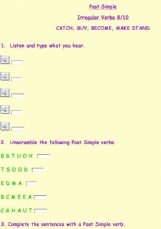

For most verbs (which we call regular verbs), we add -ed or -d to the end of the base form. Here’s a list of the List of Irregular Verbs in English A1 – A2 level for students at A1/A2 Level in English. It refers to irregular verbs that dont form their past tense by adding '-ed' to the end of the verb.An example of an irregular verb is seek. The rules are explained at the top of this page. I would recommend to students who are not studying for an exam, to start out by trying to memorise the past forms of only the verbs that they are already familiar with. This makes them easier to remember and can be particularly useful when students need to study a long list of verbs in the past form to pass an exam. While there are many irregular verbs in the past, many can be placed into phonetic groups. The verb seek also has other conjugated forms such as seeks in the third person singular in present tense and seeking in the present participle form. The past participle and the past tense of irregular verbs are not generally formed by adding (e)d or t. Try to remember the simple past form and the past participle of the verbs. To remember the V2 of seek, you need to learn it by heart. Practise again all the irregular verbs from this page using our slideshow. Be careful of irregular past tense verbs, however. The verb seek is classified as an irregular verb, so it does not follow the rules of -ed verb conjugation.

For regular verbs, you form the simple past tense by adding the suffix ed to the end of the verb (or just d if the past tense verb already ends in an e).

Students are always daunted by the seemingly endless list of irregular verbs in the past in English. Perfect tenses present perfect have sought has sought past perfectiAlso known as: pluperfect had sought had sought future perfect will have sought. We use the simple past to show actions completed in the past, with no extra emphasis. Although it was previously found that learners could not understand the inflection of irregular verbs in the past simple tense, after having utilised these two strategies, the inflection of.


 0 kommentar(er)
0 kommentar(er)
